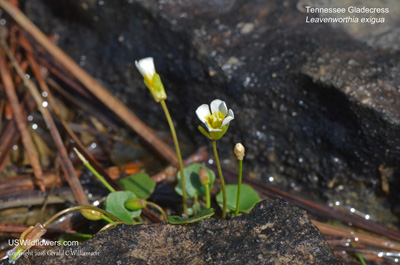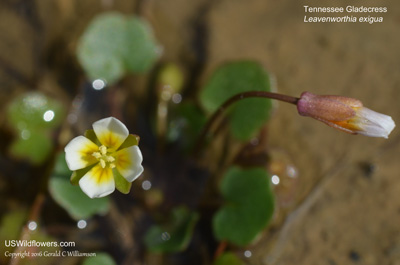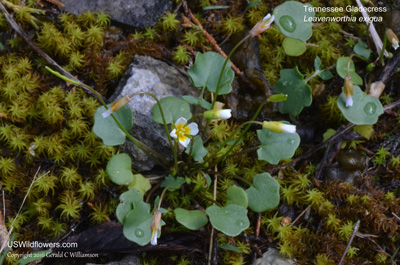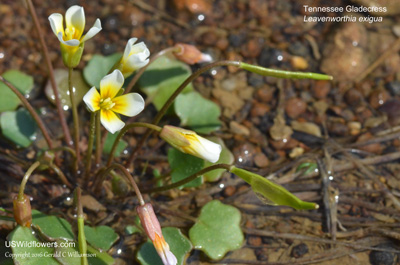Wildflowers of the United States | |||||||||||||
| |||||||||||||
Leavenworthia exigua - Tennessee Gladecress, Least Glade-cress, Pasture Gladecress, Kentucky Gladecress. Leavenworthia - Gladecress - is a small genus of 8 species (7 if you don't subscribe to the separation of Leavenworthia aurea var. texana to species status as Leavenworthia texana) endemic to the southern and southeastern states, some reaching southern Indiana and Ohio at the most northern part of their range, as far west as eastern Texas and Oklahoma. These winter annuals are found in cedar and limestone glades and other nearby areas of thin soils that are saturated during the winter and spring, but dry during the summer and fall. The seeds of these winter annuals germinate during the autumn, and the plant overwinters in the wet environment as a small rosette of leaves. The flowers and seeds come in the early spring while it is still wet, then the seeds lie dormant during the late spring and summer dry season, a season which is desert-like in the cedar and limestone glades.
| Leavenworthia exigua is one of the more widely distributed species in the genus, found in 4 states. Only L. uniflora (Michaux's Gladecress) - found in 9 states - has wider distribution. L. exigua is considered by most authorities to have three varieties, although there appears to be some consideration that the varieties are simply forms of the species. L. exigua var. exigua, Tennessee Gladecress, is endemic to limestone glades of several counties in central Tennessee and two counties in northwest Georgia. L. exigua var. lutea, also known as Tennessee Gladecress, has entirely yellow petals and is endemic to limestone glades of one county in Alabama and two counties in Tennessee. The third variety, L. exigua var. laciniata, is known as Kentucky Gladecress and is found in limestone glades of a few counties in Kentucky. It is rare and protected in all four states where it is found. Leavenworthia exigua var. exigua is what is presented on this page. Found in: AL, GA, KY, TN Leave comments on Leavenworthia exigua at this link.   Blue=Native; Grey=Introduced Map from USDA Plants Database: USDA, NRCS. 2017. The PLANTS Database (http://plants.usda.gov, 03 Apr 2025). National Plant Data Team, Greensboro, NC 27401-4901 USA. Search Our Database: Enter any portion of the Scientific, Common Name, or both. Do a general Google search of the entire site: #ad #ad
| #ad
| | ||||||||||
|
Commercial / Cookie Notice Looking for Wildflowers for a specific state? Check here: | |||||||||||||
|
| |||||||||||||





